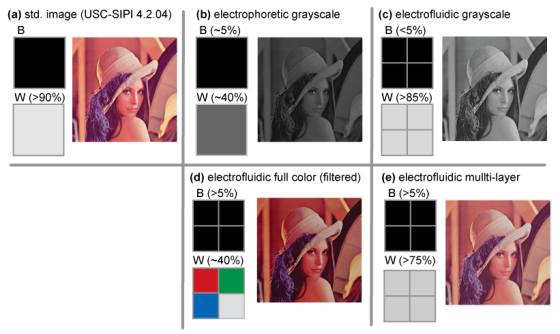Electrofluidic Display technology – visual brilliance as in conventional printed media
![]() Are you thinking about getting an e-reader but you’re not a fan of reading from a dimmed screen? A new technology called Electrofluidic Display (EFD) technology is going to change your mind. EFD is a product of an international collaboration of the University of Cincinnati, Sun Chemical, Polymer Vision and Gamma Dynamics. It’s the first technology which is able to electrically switch the appearance of pigments in a way that provides visual brilliance equal to conventional printed media.This new entry into the race for full-color electronic paper can potentially provide better than 85 percent “white-state reflectance,” a performance level required for consumers to accept reflective display applications such as portable electronics, e-paper, electronic-windows, point-of-purchase displays and adaptive camouflage.
Are you thinking about getting an e-reader but you’re not a fan of reading from a dimmed screen? A new technology called Electrofluidic Display (EFD) technology is going to change your mind. EFD is a product of an international collaboration of the University of Cincinnati, Sun Chemical, Polymer Vision and Gamma Dynamics. It’s the first technology which is able to electrically switch the appearance of pigments in a way that provides visual brilliance equal to conventional printed media.This new entry into the race for full-color electronic paper can potentially provide better than 85 percent “white-state reflectance,” a performance level required for consumers to accept reflective display applications such as portable electronics, e-paper, electronic-windows, point-of-purchase displays and adaptive camouflage.
The long-term goal of reflective displays is to mimic the appearance of pigment on paper. This means more than just bright color, the reflection also has to be diffused (not specular like a mirror).
Electrofluidic displays place an aqueous pigment dispersion inside a tiny reservoir. The reservoir comprises less than 5 to 10 percent of the viewable pixel area and therefore the pigment is substantially hidden from view. Voltage is used to electromechanically pull the pigment out of the reservoir and spread it as a film directly behind the viewing substrate. As a result, the display takes on color and brightness similar to that of conventional pigments printed on paper. When voltage is removed liquid surface tension causes the pigment dispersion to rapidly recoil into the reservoir.
“If you compare this technology to what’s been developed previously, there’s no comparison,” says developer Jason Heikenfeld, assistant professor of electrical engineering in UC’s College of Engineering. “We’re ahead by a wide margin in critical categories such as brightness, color saturation and video speed.”
This work, which has been underway for several years, has just been published in the paper “Electrofluidic displays using Young-Laplace transposition of brilliant pigment dispersions.”
“The ultimate reflective display would simply place the best colorants used by the printing industry directly beneath the front viewing substrate of a display,” says lead author Heikenfeld. “In our EFD pixels, we are able to hide or reveal colored pigment in a manner that is optically superior to the techniques used in electrowetting, electrophoretic and electrochromic displays.”
Because the optically active layer can be less than 15 microns thick, project partners at PolymerVision see strong potential for rollable displays. The product offerings could be extremely diverse, including electronic windows and tunable color casings on portable electronics.










Leave your response!